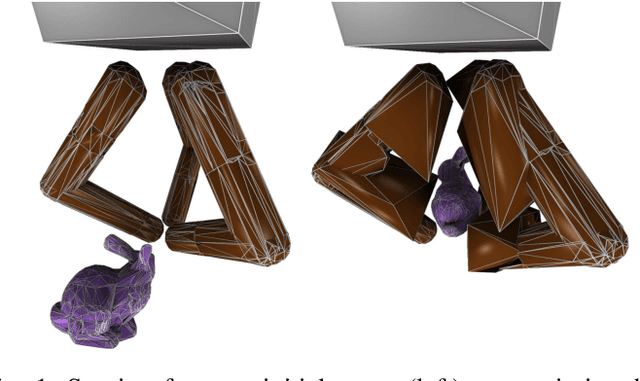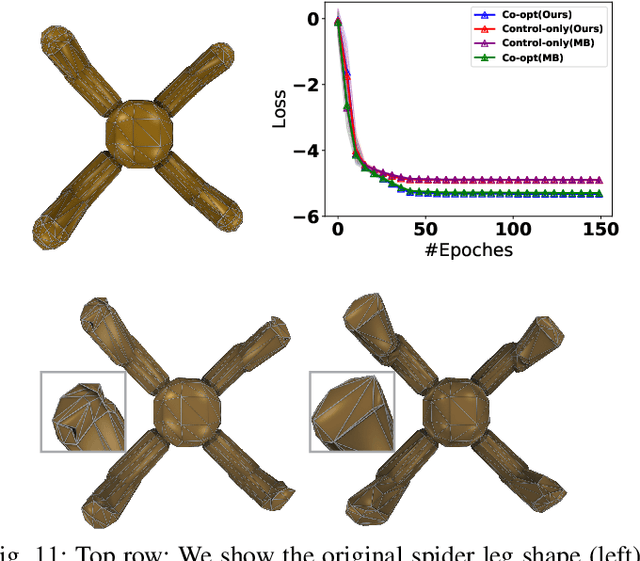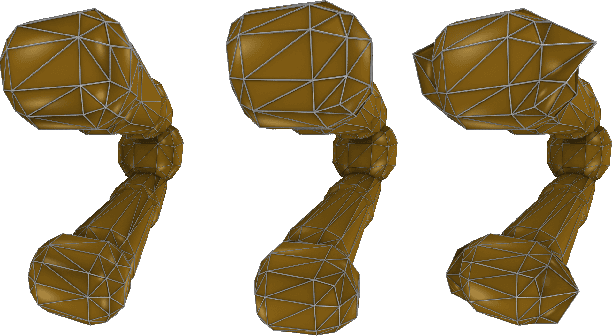Kui Wu
TrackVLA++: Unleashing Reasoning and Memory Capabilities in VLA Models for Embodied Visual Tracking
Oct 08, 2025Abstract:Embodied Visual Tracking (EVT) is a fundamental ability that underpins practical applications, such as companion robots, guidance robots and service assistants, where continuously following moving targets is essential. Recent advances have enabled language-guided tracking in complex and unstructured scenes. However, existing approaches lack explicit spatial reasoning and effective temporal memory, causing failures under severe occlusions or in the presence of similar-looking distractors. To address these challenges, we present TrackVLA++, a novel Vision-Language-Action (VLA) model that enhances embodied visual tracking with two key modules, a spatial reasoning mechanism and a Target Identification Memory (TIM). The reasoning module introduces a Chain-of-Thought paradigm, termed Polar-CoT, which infers the target's relative position and encodes it as a compact polar-coordinate token for action prediction. Guided by these spatial priors, the TIM employs a gated update strategy to preserve long-horizon target memory, ensuring spatiotemporal consistency and mitigating target loss during extended occlusions. Extensive experiments show that TrackVLA++ achieves state-of-the-art performance on public benchmarks across both egocentric and multi-camera settings. On the challenging EVT-Bench DT split, TrackVLA++ surpasses the previous leading approach by 5.1 and 12, respectively. Furthermore, TrackVLA++ exhibits strong zero-shot generalization, enabling robust real-world tracking in dynamic and occluded scenarios.
Handle-based Mesh Deformation Guided By Vision Language Model
Jun 05, 2025Abstract:Mesh deformation is a fundamental tool in 3D content manipulation. Despite extensive prior research, existing approaches often suffer from low output quality, require significant manual tuning, or depend on data-intensive training. To address these limitations, we introduce a training-free, handle-based mesh deformation method. % Our core idea is to leverage a Vision-Language Model (VLM) to interpret and manipulate a handle-based interface through prompt engineering. We begin by applying cone singularity detection to identify a sparse set of potential handles. The VLM is then prompted to select both the deformable sub-parts of the mesh and the handles that best align with user instructions. Subsequently, we query the desired deformed positions of the selected handles in screen space. To reduce uncertainty inherent in VLM predictions, we aggregate the results from multiple camera views using a novel multi-view voting scheme. % Across a suite of benchmarks, our method produces deformations that align more closely with user intent, as measured by CLIP and GPTEval3D scores, while introducing low distortion -- quantified via membrane energy. In summary, our approach is training-free, highly automated, and consistently delivers high-quality mesh deformations.
TrackVLA: Embodied Visual Tracking in the Wild
May 29, 2025Abstract:Embodied visual tracking is a fundamental skill in Embodied AI, enabling an agent to follow a specific target in dynamic environments using only egocentric vision. This task is inherently challenging as it requires both accurate target recognition and effective trajectory planning under conditions of severe occlusion and high scene dynamics. Existing approaches typically address this challenge through a modular separation of recognition and planning. In this work, we propose TrackVLA, a Vision-Language-Action (VLA) model that learns the synergy between object recognition and trajectory planning. Leveraging a shared LLM backbone, we employ a language modeling head for recognition and an anchor-based diffusion model for trajectory planning. To train TrackVLA, we construct an Embodied Visual Tracking Benchmark (EVT-Bench) and collect diverse difficulty levels of recognition samples, resulting in a dataset of 1.7 million samples. Through extensive experiments in both synthetic and real-world environments, TrackVLA demonstrates SOTA performance and strong generalizability. It significantly outperforms existing methods on public benchmarks in a zero-shot manner while remaining robust to high dynamics and occlusion in real-world scenarios at 10 FPS inference speed. Our project page is: https://pku-epic.github.io/TrackVLA-web.
VLM Can Be a Good Assistant: Enhancing Embodied Visual Tracking with Self-Improving Vision-Language Models
May 28, 2025Abstract:We introduce a novel self-improving framework that enhances Embodied Visual Tracking (EVT) with Vision-Language Models (VLMs) to address the limitations of current active visual tracking systems in recovering from tracking failure. Our approach combines the off-the-shelf active tracking methods with VLMs' reasoning capabilities, deploying a fast visual policy for normal tracking and activating VLM reasoning only upon failure detection. The framework features a memory-augmented self-reflection mechanism that enables the VLM to progressively improve by learning from past experiences, effectively addressing VLMs' limitations in 3D spatial reasoning. Experimental results demonstrate significant performance improvements, with our framework boosting success rates by $72\%$ with state-of-the-art RL-based approaches and $220\%$ with PID-based methods in challenging environments. This work represents the first integration of VLM-based reasoning to assist EVT agents in proactive failure recovery, offering substantial advances for real-world robotic applications that require continuous target monitoring in dynamic, unstructured environments. Project website: https://sites.google.com/view/evt-recovery-assistant.
Hierarchical Instruction-aware Embodied Visual Tracking
May 27, 2025Abstract:User-Centric Embodied Visual Tracking (UC-EVT) presents a novel challenge for reinforcement learning-based models due to the substantial gap between high-level user instructions and low-level agent actions. While recent advancements in language models (e.g., LLMs, VLMs, VLAs) have improved instruction comprehension, these models face critical limitations in either inference speed (LLMs, VLMs) or generalizability (VLAs) for UC-EVT tasks. To address these challenges, we propose \textbf{Hierarchical Instruction-aware Embodied Visual Tracking (HIEVT)} agent, which bridges instruction comprehension and action generation using \textit{spatial goals} as intermediaries. HIEVT first introduces \textit{LLM-based Semantic-Spatial Goal Aligner} to translate diverse human instructions into spatial goals that directly annotate the desired spatial position. Then the \textit{RL-based Adaptive Goal-Aligned Policy}, a general offline policy, enables the tracker to position the target as specified by the spatial goal. To benchmark UC-EVT tasks, we collect over ten million trajectories for training and evaluate across one seen environment and nine unseen challenging environments. Extensive experiments and real-world deployments demonstrate the robustness and generalizability of HIEVT across diverse environments, varying target dynamics, and complex instruction combinations. The complete project is available at https://sites.google.com/view/hievt.
CALM: Co-evolution of Algorithms and Language Model for Automatic Heuristic Design
May 18, 2025Abstract:Tackling complex optimization problems often relies on expert-designed heuristics, typically crafted through extensive trial and error. Recent advances demonstrate that large language models (LLMs), when integrated into well-designed evolutionary search frameworks, can autonomously discover high-performing heuristics at a fraction of the traditional cost. However, existing approaches predominantly rely on verbal guidance, i.e., manipulating the prompt generation process, to steer the evolution of heuristics, without adapting the underlying LLM. We propose a hybrid framework that combines verbal and numerical guidance, the latter achieved by fine-tuning the LLM via reinforcement learning based on the quality of generated heuristics. This joint optimization allows the LLM to co-evolve with the search process. Our method outperforms state-of-the-art (SOTA) baselines across various optimization tasks, running locally on a single 24GB GPU using a 7B model with INT4 quantization. It surpasses methods that rely solely on verbal guidance, even when those use significantly more powerful API-based models.
BC-ADMM: An Efficient Non-convex Constrained Optimizer with Robotic Applications
Apr 07, 2025Abstract:Non-convex constrained optimizations are ubiquitous in robotic applications such as multi-agent navigation, UAV trajectory optimization, and soft robot simulation. For this problem class, conventional optimizers suffer from small step sizes and slow convergence. We propose BC-ADMM, a variant of Alternating Direction Method of Multiplier (ADMM), that can solve a class of non-convex constrained optimizations with biconvex constraint relaxation. Our algorithm allows larger step sizes by breaking the problem into small-scale sub-problems that can be easily solved in parallel. We show that our method has both theoretical convergence speed guarantees and practical convergence guarantees in the asymptotic sense. Through numerical experiments in a row of four robotic applications, we show that BC-ADMM has faster convergence than conventional gradient descent and Newton's method in terms of wall clock time.
UnrealZoo: Enriching Photo-realistic Virtual Worlds for Embodied AI
Dec 30, 2024



Abstract:We introduce UnrealZoo, a rich collection of photo-realistic 3D virtual worlds built on Unreal Engine, designed to reflect the complexity and variability of the open worlds. Additionally, we offer a variety of playable entities for embodied AI agents. Based on UnrealCV, we provide a suite of easy-to-use Python APIs and tools for various potential applications, such as data collection, environment augmentation, distributed training, and benchmarking. We optimize the rendering and communication efficiency of UnrealCV to support advanced applications, such as multi-agent interaction. Our experiments benchmark agents in various complex scenes, focusing on visual navigation and tracking, which are fundamental capabilities for embodied visual intelligence. The results yield valuable insights into the advantages of diverse training environments for reinforcement learning (RL) agents and the challenges faced by current embodied vision agents, including those based on RL and large vision-language models (VLMs), in open worlds. These challenges involve latency in closed-loop control in dynamic scenes and reasoning about 3D spatial structures in unstructured terrain.
SDRS: Shape-Differentiable Robot Simulator
Dec 26, 2024



Abstract:Robot simulators are indispensable tools across many fields, and recent research has significantly improved their functionality by incorporating additional gradient information. However, existing differentiable robot simulators suffer from non-differentiable singularities, when robots undergo substantial shape changes. To address this, we present the Shape-Differentiable Robot Simulator (SDRS), designed to be differentiable under significant robot shape changes. The core innovation of SDRS lies in its representation of robot shapes using a set of convex polyhedrons. This approach allows us to generalize smooth, penalty-based contact mechanics for interactions between any pair of convex polyhedrons. Using the separating hyperplane theorem, SDRS introduces a separating plane for each pair of contacting convex polyhedrons. This separating plane functions as a zero-mass auxiliary entity, with its state determined by the principle of least action. This setup ensures global differentiability, even as robot shapes undergo significant geometric and topological changes. To demonstrate the practical value of SDRS, we provide examples of robot co-design scenarios, where both robot shapes and control movements are optimized simultaneously.
BehaviorGPT: Smart Agent Simulation for Autonomous Driving with Next-Patch Prediction
May 27, 2024



Abstract:Simulating realistic interactions among traffic agents is crucial for efficiently validating the safety of autonomous driving systems. Existing leading simulators primarily use an encoder-decoder structure to encode the historical trajectories for future simulation. However, such a paradigm complicates the model architecture, and the manual separation of history and future trajectories leads to low data utilization. To address these challenges, we propose Behavior Generative Pre-trained Transformers (BehaviorGPT), a decoder-only, autoregressive architecture designed to simulate the sequential motion of multiple agents. Crucially, our approach discards the traditional separation between "history" and "future," treating each time step as the "current" one, resulting in a simpler, more parameter- and data-efficient design that scales seamlessly with data and computation. Additionally, we introduce the Next-Patch Prediction Paradigm (NP3), which enables models to reason at the patch level of trajectories and capture long-range spatial-temporal interactions. BehaviorGPT ranks first across several metrics on the Waymo Sim Agents Benchmark, demonstrating its exceptional performance in multi-agent and agent-map interactions. We outperformed state-of-the-art models with a realism score of 0.741 and improved the minADE metric to 1.540, with an approximately 91.6% reduction in model parameters.
 Add to Chrome
Add to Chrome Add to Firefox
Add to Firefox Add to Edge
Add to Edge